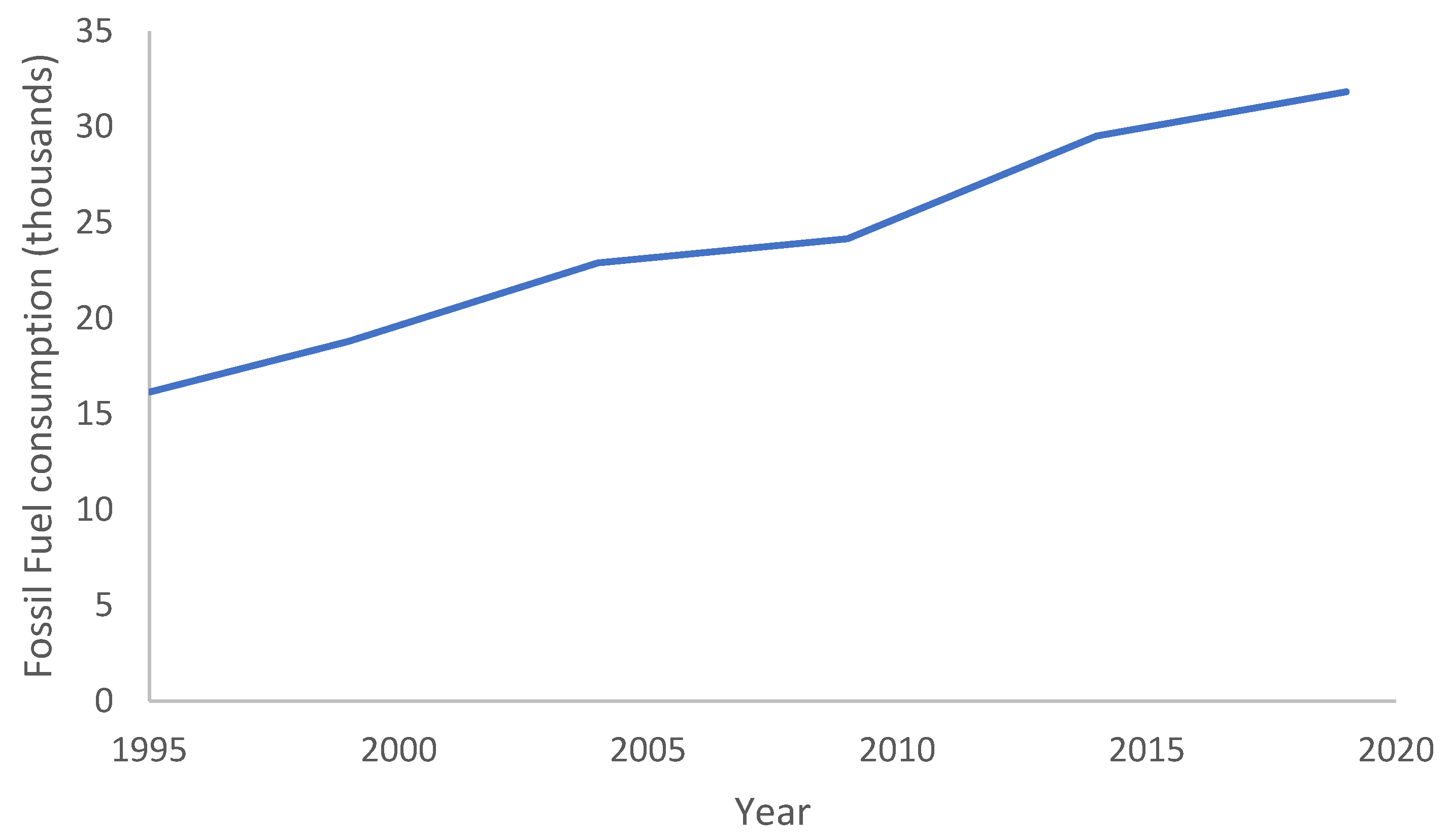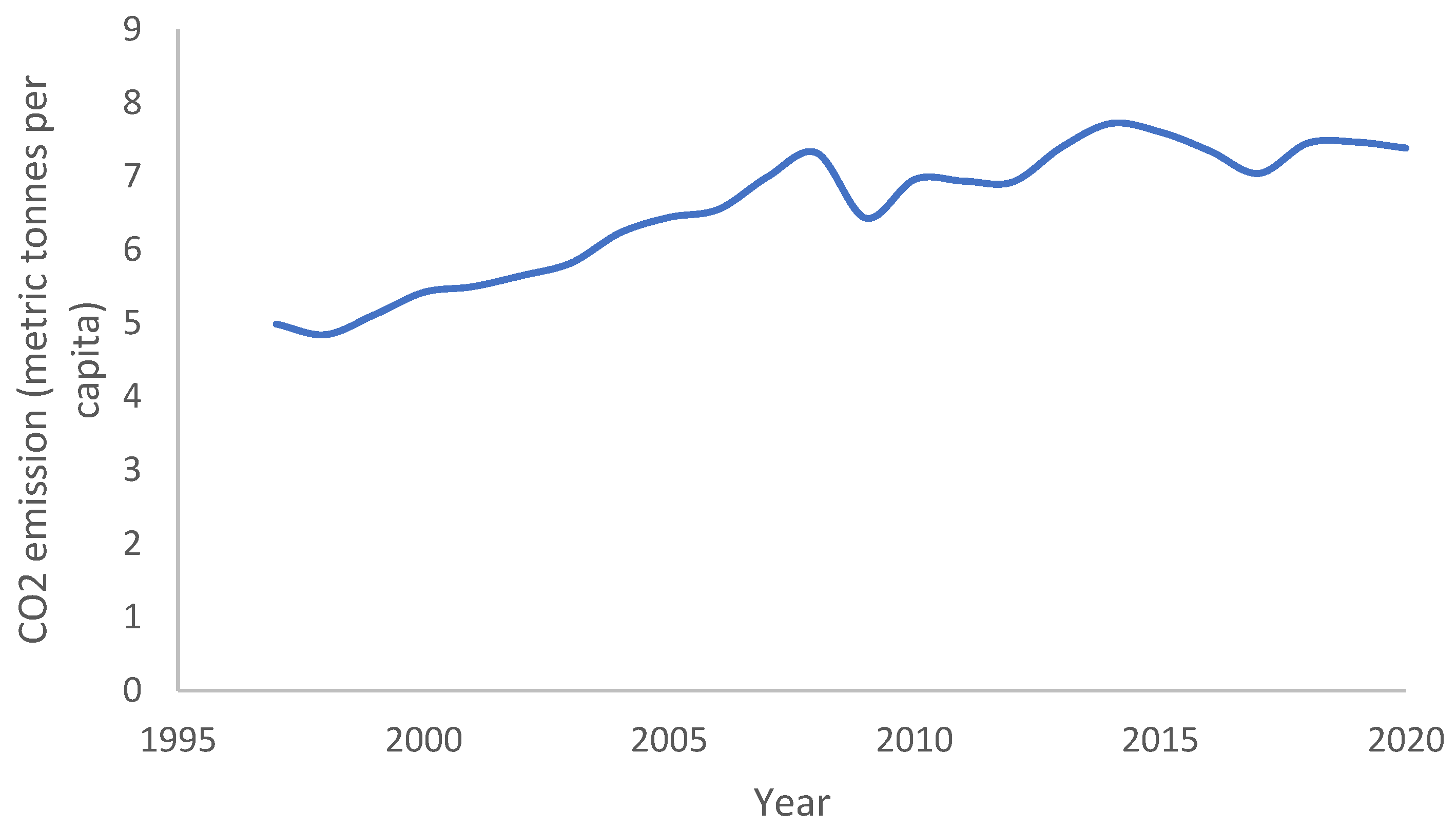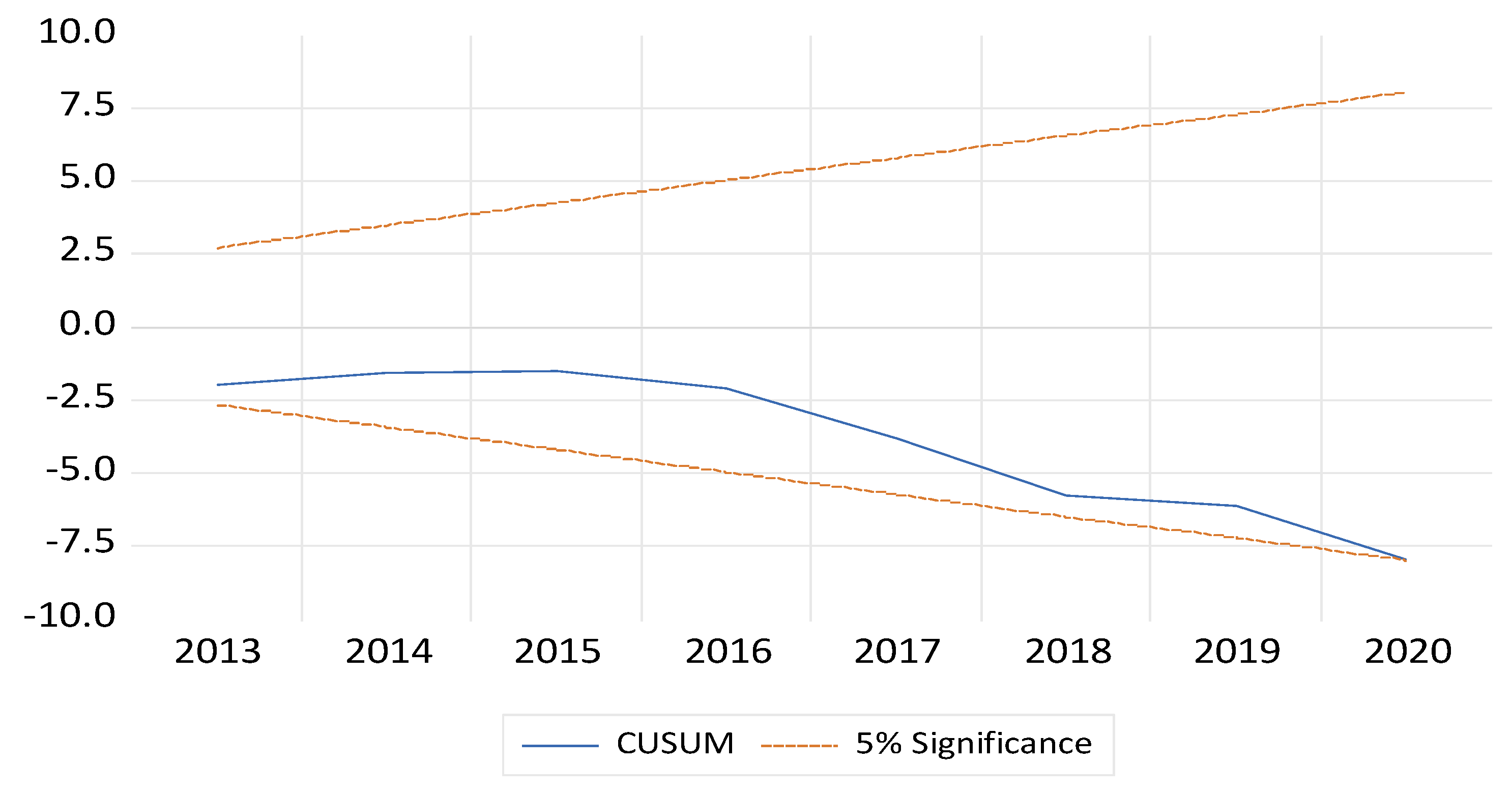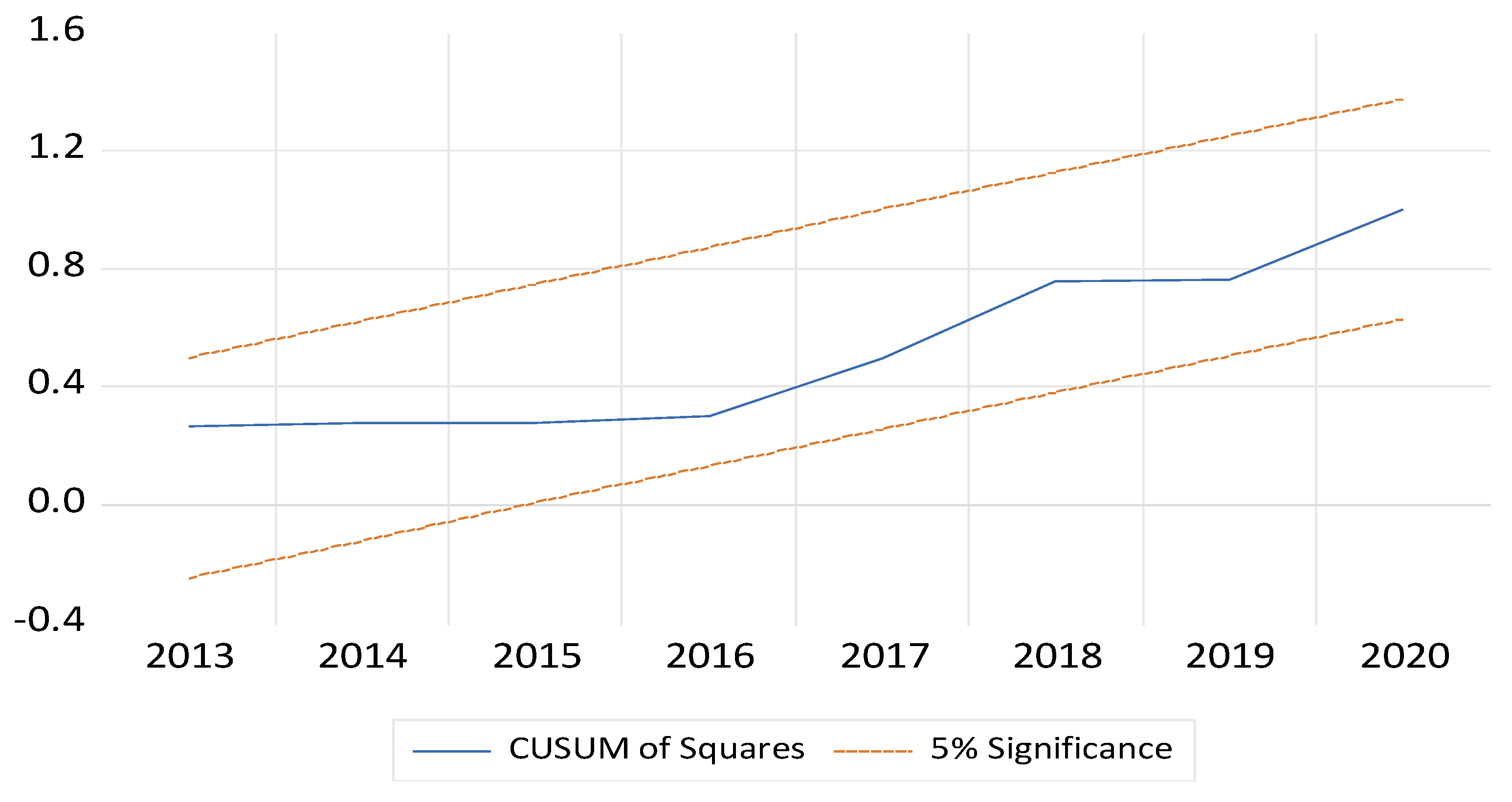Analyzing the Influence of Energy Consumption and Economic Complexity on Carbon Emissions: Evidence from Malaysia
Abstract
1. Introduction
2. Literature Review
2.1. Economic Growth and Environmental Pollution
2.2. Economic Complexity and Environmental Pollution
2.3. Energy Consumption and Environmental Contamination
3. Methodology
3.1. Data Definition
3.2. Empirical Model and Estimation Methods
4. Results and Discussion
5. Policy Implications
6. Conclusions
Author Contributions
Funding
Institutional Review Board Statement
Informed Consent Statement
Data Availability Statement
Acknowledgments
Conflicts of Interest
References
- Hatmanu, M.; Cautisanu, C.; Iacobuta, A.O. On the relationships between CO2 emissions and their determinants in Romania and Bulgaria. An ARDL approach. Appl. Econ. 2022, 54, 2582–2595. [Google Scholar] [CrossRef]
- World Bank. World Development Indicators (WDI); Data Series by the World Bank Group; The World Bank: Washington, DC, USA, 2021; Available online: https://databank.worldbank.org/source/world-development-indicators (accessed on 11 May 2024).
- Gan, P.Y.; Li, Z. An econometric study on long-term energy outlook and the implications of renewable energy utilization in Malaysia. Energy Policy 2008, 36, 890–899. [Google Scholar] [CrossRef]
- United Nations Framework Convention on Climate Change. Statement by Mr. Tuan Ibrahim Tuan Man Honourable Minister of Environment and Water. 2021. Available online: https://unfccc.int/sites/default/files/resource/MALAYSIA_cop26cmp16cma3_HLS_EN.pdf (accessed on 11 May 2024).
- Grossman, G.M.; Krueger, A.B. Environmental Impacts of a North American Free Trade Agreement; NBER Working Papers 3914; National Bureau of Economic Research Inc.: Cambridge, MA, USA, 1991. [Google Scholar]
- Panayotou, T. Empirical Tests and Policy Analysis of Environmental Degradation at Different Stages of Economic Development; ILO Working Papers 992927783402676; International Labour Organization: Genève, Switzerland, 1993. [Google Scholar]
- Hidalgo, C.A.; Hausmann, R. The building blocks of economic complexity. Proc. Natl. Acad. Sci. USA 2009, 106, 10570–10575. [Google Scholar] [CrossRef] [PubMed]
- Hausmann, R.; Hidalgo, C.A.; Bustos, S.; Coscia, M.; Simoes, A. The Atlas of Economic Complexity: Mapping Paths to Prosperity; MIT Press: Cambridge, MA, USA, 2014. [Google Scholar]
- Hausmann, R.; Hidalgo, C.; Bustos, S.; Coscia, M.; Simoes, A.; Yildirim, M.A. The Atlas of Economics Complexity—Mapping Paths to Prosperity; Center for International Development, Harvard University: Cambridge, MA, USA, 2011. [Google Scholar]
- Swart, J.; Brinkmann, L. Economic complexity and the environment: Evidence from Brazil. In Universities and Sustainable Communities: Meeting the Goals of the Agenda 2030; Springer International Publishing: New York, NY, USA, 2020; pp. 3–45. [Google Scholar]
- Azlina, A.A.; Mustapha, N.N. Energy, economic growth and pollutant emissions nexus: The case of Malaysia. Procedia-Soc. Behav. Sci. 2012, 65, 1–7. [Google Scholar] [CrossRef]
- Begum, R.A.; Sohag, K.; Abdullah SM, S.; Jaafar, M. CO2 emissions, energy consumption, economic and population growth in Malaysia. Renew. Sustain. Energy Rev. 2015, 41, 594–601. [Google Scholar] [CrossRef]
- Ali, U.; Guo, Q.; Kartal, M.T.; Nurgazina, Z.; Khan, Z.A.; Sharif, A. The impact of renewable and non-renewable energy consumption on carbon emission intensity in China: Fresh evidence from novel dynamic ARDL simulations. J. Environ. Manag. 2022, 320, 115782. [Google Scholar] [CrossRef] [PubMed]
- Raihan, A.; Tuspekova, A. Toward a sustainable environment: Nexus between economic growth, renewable energy use, forested area, and carbon emissions in Malaysia. Resour. Conserv. Recycl. Adv. 2022, 15, 200096. [Google Scholar] [CrossRef]
- Sharif, A.; Sofuoglu, E.; Kocak, S.; Anwar, A. Can green finance and energy provide a Glimmer of hope towards a sustainable environment in the midst of chaos? Evidence from Malaysia. Renew. Energy 2024, 223, 119982. [Google Scholar] [CrossRef]
- Shafique, M.; Azam, A.; Rafiq, M.; Luo, X. Evaluating the relationship between freight transport, economic prosperity, urbanization, and CO2 emissions: Evidence from Hong Kong, Singapore, and South Korea. Sustainability 2020, 12, 10664. [Google Scholar] [CrossRef]
- Azam, A.; Rafiq, M.; Shafique, M.; Zhang, H.; Yuan, J. Analyzing the effect of natural gas, nuclear energy and renewable energy on GDP and carbon emissions: A multi-variate panel data analysis. Energy 2021, 219, 119592. [Google Scholar] [CrossRef]
- Shafique, M.; Azam, A.; Rafiq, M.; Luo, X. Investigating the nexus among transport, economic growth and environmental degradation: Evidence from panel ARDL approach. Transp. Policy 2021, 109, 61–71. [Google Scholar] [CrossRef]
- Shin, Y.; Yu, B. An ARDL Approach to an Analysis of Asymmetric Long-Run Cointegrating Relationships; Leeds University Business School: Leeds, UK, 2004. [Google Scholar]
- Dickey, D.A.; Fuller, W.A. Distribution of the estimators for autoregressive time series with a unit root. J. Am. Stat. Assoc. 1979, 74, 427–431. [Google Scholar]
- Phillips, P.C.; Perron, P. Testing for a unit root in time series regression. Biometrika 1988, 75, 335–346. [Google Scholar] [CrossRef]
- Makarov, I.; Alataş, S. Production-and consumption-based emissions in carbon exporters and importers: A large panel data analysis for the EKC hypothesis. Appl. Energy 2024, 363, 123063. [Google Scholar] [CrossRef]
- Mohamed, E.F.; Abdullah, A.; Jaaffar, A.H.; Osabohien, R. Reinvestigating the EKC hypothesis: Does renewable energy in power generation reduce carbon emissions and ecological footprint? Energy Strategy Rev. 2024, 53, 101387. [Google Scholar] [CrossRef]
- Chopra, R.; Rehman, M.A.; Yadav, A.; Bhardwaj, S. Revisiting the EKC framework concerning COP-28 carbon neutrality management: Evidence from Top-5 carbon embittering countries. J. Environ. Manag. 2024, 356, 120690. [Google Scholar] [CrossRef]
- Fan, L.; Usman, M.; Haseeb, M.; Kamal, M. The impact of financial development and energy consumption on ecological footprint in economic complexity-based EKC framework: New evidence from BRICS-T region. In Natural Resources Forum; Blackwell Publishing Ltd.: Oxford, UK, 2024. [Google Scholar]
- Fang, P. Short-term carbon emission prediction method of green building based on IPAT model. Int. J. Glob. Energy Issues 2023, 45, 1–13. [Google Scholar]
- Poumanyvong, P.; Kaneko, S. Does urbanization lead to less energy use and lower CO2 emissions? A cross-country analysis. Ecol. Econ. 2010, 70, 434–444. [Google Scholar] [CrossRef]
- Li, K.; Lin, B. Impacts of urbanization and industrialization on energy consumption/CO2 emissions: Does the level of development matter? Renew. Sustain. Energy Rev. 2015, 52, 1107–1122. [Google Scholar] [CrossRef]
- Odugbesan, J.A.; Adebayo, T.S. The symmetrical and asymmetrical effects of foreign direct investment and financial development on carbon emission: Evidence from Nigeria. SN Appl. Sci. 2020, 2, 1982. [Google Scholar] [CrossRef]
- Adebayo, T.S.; Awosusi, A.A.; Adeshola, I. Determinants of CO2 emissions in emerging markets: An empirical evidence from MINT economies. Int. J. Renew. Energy Dev. 2020, 9, 411–422. [Google Scholar] [CrossRef]
- Adebayo, T.S.; Kalmaz, D.B. Determinants of CO2 emissions: Empirical evidence from Egypt. Environ. Ecol. Stat. 2021, 28, 239–262. [Google Scholar] [CrossRef]
- Teng, J.Z.; Khan, M.K.; Khan, M.I.; Chishti, M.Z.; Khan, M.O. Effect of foreign direct investment on CO2 emission with the role of globalization, institutional quality with pooled mean group panel ARDL. Environ. Sci. Pollut. Res. Int. 2021, 28, 5271–5282. [Google Scholar] [CrossRef] [PubMed]
- Nondo, C.; Kahsai, M.S. The impact of energy intensity, urbanisation, industrialisation, and income on CO2 emissions in South Africa: An ARDL bounds testing approach. Afr. J. Econ. Sustain. Dev. 2020, 7, 307–330. [Google Scholar]
- Zhang, L.; Li, Z.; Kirikkaleli, D.; Adebayo, T.S.; Adeshola, I.; Akinsola, G.D. Modelling CO2 emissions in Malaysia: An application of Maki cointegration and wavelet coherence tests. Environ. Sci. Pollut. Res. 2021, 28, 26030–26044. [Google Scholar]
- Aşıcı, A.A. Economic growth and its impact on the environment: A panel data analysis. Ecol. Indic. 2013, 24, 324–333. [Google Scholar] [CrossRef]
- Htike, M.M.; Shrestha, A.; Kakinaka, M. Investigating whether the environmental Kuznets curve hypothesis holds for sectoral CO2 emissions: Evidence from developed and developing countries. Environ. Dev. Sustain. 2021, 24, 12712–12739. [Google Scholar] [CrossRef]
- Le, H.P.; Ozturk, I. The impacts of globalization, financial development, government expenditures, and institutional quality on CO2 emissions in the presence of environmental Kuznets curve. Environ. Sci. Pollut. Res. 2020, 27, 22680–22697. [Google Scholar] [CrossRef] [PubMed]
- Kong, Y.; Khan, R. To examine environmental pollution by economic growth and their impact on an environmental Kuznets curve (EKC) among developed and developing countries. PLoS ONE 2019, 14, e0209532. [Google Scholar] [CrossRef]
- Can, M.; Gozgor, G. The impact of economic complexity on carbon emissions: Evidence from France. Environ. Sci. Pollut. Res. 2017, 24, 16364–16370. [Google Scholar] [CrossRef]
- Doğan, B.; Saboori, B.; Can, M. Does economic complexity matter for environmental degradation? An empirical analysis for different stages of development. Environ. Sci. Pollut. Res. 2019, 26, 31900–31912. [Google Scholar] [CrossRef]
- Ahmed, Z.; Can, M.; Sinha, A.; Ahmad, M.; Alvarado, R.; Rjoub, H. Investigating the role of economic complexity in sustainable development and environmental sustainability. Int. J. Sustain. Dev. World Ecol. 2022, 29, 771–783. [Google Scholar] [CrossRef]
- Laverde-Rojas, H.; Guevara-Fletcher, D.A.; Camacho-Murillo, A. Economic growth, economic complexity, and carbon dioxide emissions: The case of Colombia. Heliyon 2021, 7, e07188. [Google Scholar] [CrossRef] [PubMed]
- Bucher, F.; Scheu, L.; Schröpf, B. Economic Complexity and Environmental Pollution: Evidence from the Former Socialist; No. 218; BGPE Discussion Paper; Friedrich-Alexander-Universität Erlangen-Nürnberg: Erlangen, Germany, 2022. [Google Scholar]
- Kirikkaleli, D.; Sofuoğlu, E.; Abbasi, K.R.; Addai, K. Economic complexity and environmental sustainability in eastern European economy: Evidence from novel Fourier approach. Reg. Sustain. 2023, 4, 349–358. [Google Scholar] [CrossRef]
- Karasoy, A.; Akçay, S. Effects of renewable energy consumption and trade on environmental pollution: The Turkish case. Manag. Environ. Qual. Int. J. 2018, 30, 437–455. [Google Scholar] [CrossRef]
- Sarkodie, S.A.; Adams, S. Renewable energy, nuclear energy, and environmental pollution: Accounting for political institutional quality in South Africa. Sci. Total Environ. 2018, 643, 1590–1601. [Google Scholar] [CrossRef] [PubMed]
- Idowu, K.A.; Adeneye, Y.B. Inequality and economic growth: An analysis of 8-Panels. J. Econ. Public Financ. 2017, 3, 173–187. [Google Scholar] [CrossRef]
- Assi, A.F.; Isiksal, A.Z.; Tursoy, T. Highlighting the connection between financial development and consumption of energy in countries with the highest economic freedom. Energy Policy 2020, 147, 111897. [Google Scholar] [CrossRef]
- Khan, M.K.; Khan, M.I.; Rehan, M. The relationship between energy consumption, economic growth and carbon dioxide emissions in Pakistan. Financ. Innov. 2020, 6, 1–13. [Google Scholar] [CrossRef]
- Chien, F.; Hsu, C.C.; Zhang, Y.; Tran, T.D.; Li, L. Assessing the impact of green fiscal policies and energy poverty on energy efficiency. Environ. Sci. Pollut. Res. 2022, 29, 4363–4374. [Google Scholar] [CrossRef]
- Alam, M.B.; Hossain, M.S. Investigating the connections between China’s economic growth, use of renewable energy, and research and development concerning CO2 emissions: An ARDL Bound Test Approach. Technol. Forecast. Soc. Chang. 2024, 201, 123220. [Google Scholar] [CrossRef]
- Pesaran, M.H.; Shin, Y.; Smith, R.J. Bounds testing approaches to the analysis of level relationships. J. Appl. Econom. 2001, 16, 289–326. [Google Scholar] [CrossRef]
- Madzaki, H.; Ghani, W.A.W.A.K.; Yaw, T.C.S.; Rashid, U.; Muda, N. Carbon dioxide adsorption on activated carbon hydrothermally treated and impregnated with metal oxides. J. Kejuruter. 2018, 30, 31–38. [Google Scholar]
- Ahmed, S.; Ahmed, K.; Ismail, M. Predictive analysis of CO2 emissions and the role of environmental technology, energy use and economic output: Evidence from emerging economies. Air Qual. Atmos. Health 2020, 13, 1035–1044. [Google Scholar] [CrossRef]
- Yin, Q.; Wang, Y.; Xu, Z.; Wan, K.; Wang, D. Factors influencing green transformation efficiency in China’s mineral resource-based cities: Method analysis based on IPAT-E and PLS-SEM. J. Clean. Prod. 2022, 330, 129783. [Google Scholar] [CrossRef]






| lnCO2 | lnECI | lnGDP | lnGDP2 | lnEC | |
|---|---|---|---|---|---|
| Mean | 8.261 | −0.344 | 3.903 | 15.238 | 3.028 |
| Median | 8.284 | −0.069 | 3.895 | 15.168 | 2.964 |
| Maximum | 8.430 | 0.051 | 4.046 | 16.369 | 3.439 |
| Minimum | 8.017 | −2.235 | 3.769 | 14.210 | 2.764 |
| Std. Dev. | 0.129 | 0.629 | 0.085 | 0.668 | 0.215 |
| Skewness | −0.420 | −2.117 | 0.151 | 0.175 | 0.775 |
| Kurtosis | 1.971 | 6.463 | 1.767 | 1.773 | 2.276 |
| Jarque-Bera | 1.768 | 29.931 | 1.610 | 1.627 | 2.929 |
| Probability | 0.413 | 0.000 | 0.447 | 0.443 | 0.231 |
| Sum | 198.271 | −8.257 | 93.666 | 365.723 | 72.671 |
| Sum Sq. Dev. | 0.383 | 9.115 | 0.168 | 10.257 | 1.059 |
| Observations | 24 | 24 | 24 | 24 | 24 |
| Correlation matrix | |||||
| lnCO2 | 1.0000 | ||||
| lnECI | 0.7983 | 1.0000 | |||
| lnGDP | 0.9620 | 0.6975 | 1.0000 | ||
| lnGDP2 | 0.9600 | 0.6932 | 1.0000 | 1.0000 | |
| lnEC | 0.7585 | 0.5149 | 0.8762 | 0.8796 | 1.0000 |
| Variables | ADF Test Statistic | PP Test Statistic | ||
|---|---|---|---|---|
| Level | 1st Difference | Level | 1st Difference | |
| lnCO2 | −2.43 ** | −6.23 ** | −0.55 | −5.41 |
| lnGDP | −0.08 | −6.12 ** | 0.02 | −6.61 ** |
| lnGDP2 | −0.06 | −5.94 ** | 0.04 | −6.19 ** |
| lnEC | −1.44 | −4.26 ** | −1.43 | −4.28 ** |
| lnECI | −2.15 ** | −5.44 ** | −9.40 ** | −4.02 ** |
| Empirical Model | ||
| Optimum lag length | 2, 1, 0, 0, 0 | |
| F-statistics | 9.967 *** | |
| Significance level | Lower bound (0) | Upper bound I (1) |
| 1% | 4.4 | 5.72 |
| 2.50% | 3.89 | 5.07 |
| 5% | 3.47 | 4.57 |
| 10% | 3.03 | 4.06 |
| Variables | Coefficient | Std Error | t-Statistic | Prob |
|---|---|---|---|---|
| LnGDP | 2.071 | 0.446 | 4.634 | 0.007 ** |
| D(lnGDP) | 59.05 | 16.962 | 3.482 | 0.005 ** |
| LnGDP2 | −0.215 | 0.064 | −3.429 | 0.001 ** |
| D(LnGDP2) | −7.458 | 2.164 | −3.445 | 0.005 ** |
| LnEC | 0.978 | 0.410 | 2.368 | 0.037 ** |
| D(LnEC) | 0.429 | 0.251 | 1.709 | 0.112 |
| lnECI | 0.182 | 0.054 | 3.393 | 0.006 ** |
| D(lnECI) | 0.224 | 0.089 | 2.505 | 0.029 ** |
| ECT(−1) | −0.667 | 0.183 | −6.220 | 0.0001 * |
| R2 | 0.991 | Adjusted R2 | 0.983 | |
| Diagnostic test statistics | t-test | p-value | ||
| Lagrange multiplier test | 1.469 | 0.302 | ||
| Jarque–Bera test | 1.19 | 0.546 | ||
| Breusch–Pagan–Godfrey test | 0.713 | 0.726 |
Disclaimer/Publisher’s Note: The statements, opinions and data contained in all publications are solely those of the individual author(s) and contributor(s) and not of MDPI and/or the editor(s). MDPI and/or the editor(s) disclaim responsibility for any injury to people or property resulting from any ideas, methods, instructions or products referred to in the content. |
© 2024 by the authors. Licensee MDPI, Basel, Switzerland. This article is an open access article distributed under the terms and conditions of the Creative Commons Attribution (CC BY) license (https://creativecommons.org/licenses/by/4.0/).
Share and Cite
Afroz, R.; Alofaysan, H.; Sarabdeen, M.; Muhibbullah, M.D.; Muhammad, Y.B. Analyzing the Influence of Energy Consumption and Economic Complexity on Carbon Emissions: Evidence from Malaysia. Energies 2024, 17, 2900. https://doi.org/10.3390/en17122900
Afroz R, Alofaysan H, Sarabdeen M, Muhibbullah MD, Muhammad YB. Analyzing the Influence of Energy Consumption and Economic Complexity on Carbon Emissions: Evidence from Malaysia. Energies. 2024; 17(12):2900. https://doi.org/10.3390/en17122900
Chicago/Turabian StyleAfroz, Rafia, Hind Alofaysan, Masahina Sarabdeen, M. D. Muhibbullah, and Yahuza Baba Muhammad. 2024. "Analyzing the Influence of Energy Consumption and Economic Complexity on Carbon Emissions: Evidence from Malaysia" Energies 17, no. 12: 2900. https://doi.org/10.3390/en17122900
APA StyleAfroz, R., Alofaysan, H., Sarabdeen, M., Muhibbullah, M. D., & Muhammad, Y. B. (2024). Analyzing the Influence of Energy Consumption and Economic Complexity on Carbon Emissions: Evidence from Malaysia. Energies, 17(12), 2900. https://doi.org/10.3390/en17122900







